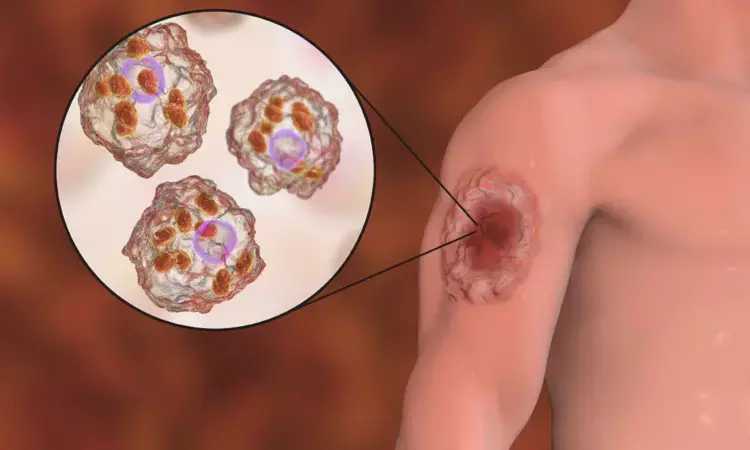- Home
- Medical news & Guidelines
- Anesthesiology
- Cardiology and CTVS
- Critical Care
- Dentistry
- Dermatology
- Diabetes and Endocrinology
- ENT
- Gastroenterology
- Medicine
- Nephrology
- Neurology
- Obstretics-Gynaecology
- Oncology
- Ophthalmology
- Orthopaedics
- Pediatrics-Neonatology
- Psychiatry
- Pulmonology
- Radiology
- Surgery
- Urology
- Laboratory Medicine
- Diet
- Nursing
- Paramedical
- Physiotherapy
- Health news
- Fact Check
- Bone Health Fact Check
- Brain Health Fact Check
- Cancer Related Fact Check
- Child Care Fact Check
- Dental and oral health fact check
- Diabetes and metabolic health fact check
- Diet and Nutrition Fact Check
- Eye and ENT Care Fact Check
- Fitness fact check
- Gut health fact check
- Heart health fact check
- Kidney health fact check
- Medical education fact check
- Men's health fact check
- Respiratory fact check
- Skin and hair care fact check
- Vaccine and Immunization fact check
- Women's health fact check
- AYUSH
- State News
- Andaman and Nicobar Islands
- Andhra Pradesh
- Arunachal Pradesh
- Assam
- Bihar
- Chandigarh
- Chattisgarh
- Dadra and Nagar Haveli
- Daman and Diu
- Delhi
- Goa
- Gujarat
- Haryana
- Himachal Pradesh
- Jammu & Kashmir
- Jharkhand
- Karnataka
- Kerala
- Ladakh
- Lakshadweep
- Madhya Pradesh
- Maharashtra
- Manipur
- Meghalaya
- Mizoram
- Nagaland
- Odisha
- Puducherry
- Punjab
- Rajasthan
- Sikkim
- Tamil Nadu
- Telangana
- Tripura
- Uttar Pradesh
- Uttrakhand
- West Bengal
- Medical Education
- Industry
Cutaneous Leishmaniasis Misdiagnosed as Diabetic Foot: Case Study Calls for Increased Vigilance in Endemic Areas

Saudi Arabia: Cutaneous leishmaniasis (CL) is a parasitic infection transmitted by sandflies, affecting millions worldwide. While the disease typically presents as an ulcerated nodule at the site of parasite inoculation, its clinical manifestations can vary significantly. A recent case published in Acta Dermatovenerologica Croatica highlights an unusual presentation of CL that was initially misdiagnosed as diabetic foot, emphasizing the need for heightened awareness and vigilance in diagnosing foot ulcers, particularly in endemic areas.
A 75-year-old man from Afghanistan, residing in a region endemic to CL, presented with a large, progressive necrotic ulcer on his left foot that had persisted for a year. The ulcer was accompanied by pain, but the patient reported no history of trauma or chronic systemic diseases. Despite multiple visits to healthcare providers in his village, where he was repeatedly diagnosed with diabetic foot, the ulcer showed no improvement after several rounds of dressing applications. Blood tests, including fasting blood sugar, revealed normal levels, which raised suspicion for a diagnosis other than diabetic foot.
Given the patient’s geographic location and the ulcer’s persistence, CL was considered, and subsequent diagnostic tests confirmed the diagnosis. A slit skin smear and skin biopsy revealed the presence of Leishmania amastigotes in the dermal histiocytic infiltrates, confirming the diagnosis of cutaneous leishmaniasis. The patient is now undergoing treatment with systemic sodium stibogluconate (pentostam), a standard therapy for CL.
Leishmaniasis, particularly CL, is a major health concern in various parts of the world, with over 1.5 million cases reported annually. While the classic form of CL is often easily diagnosed, the disease can present in unusual locations, such as the scalp, genital region, or palms and soles. Foot involvement, though rare, can be mistaken for other conditions that cause ulcerations, such as leprosy, vasculitis, or diabetic foot ulcers. The misdiagnosis of CL as diabetic foot is not uncommon, especially in endemic areas where CL is less frequently considered in differential diagnoses.
This case underscores the importance of considering CL in the differential diagnosis of chronic ulcers, especially in patients from endemic regions. Clinicians should be aware of the possibility of CL when evaluating persistent foot ulcers, particularly when typical treatments for diabetic foot fail. Routine diagnostic biopsies can be invaluable in such cases, aiding in identifying specific pathogens like Leishmania. Early diagnosis and appropriate treatment are crucial to managing CL effectively and preventing further complications.
Reference:
Al Aboud K, Al Aboud A. Cutaneous Leishmaniasis Masquerading as Diabetic Foot: A Call for Vigilance. Acta Dermatovenerol Croat. 2024 Nov;32(2):120-121. PMID: 39803740.
Dr Kamal Kant Kohli-MBBS, DTCD- a chest specialist with more than 30 years of practice and a flair for writing clinical articles, Dr Kamal Kant Kohli joined Medical Dialogues as a Chief Editor of Medical News. Besides writing articles, as an editor, he proofreads and verifies all the medical content published on Medical Dialogues including those coming from journals, studies,medical conferences,guidelines etc. Email: drkohli@medicaldialogues.in. Contact no. 011-43720751


